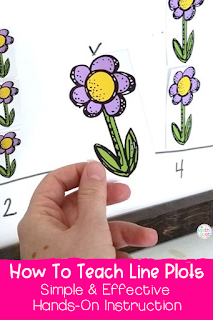Much of the “data and graphing” instruction comes quite easily to students. A bar graph or pictograph is really quite intuitive to read- the difficulty in instruction comes in when students are asked to solve comparison word problems based on the data in the charts. And we KNOW that comparison word problems are notoriously difficult for students to solve!

Why then are line plots… which are really just a combination of a bar graph and a pictograph… so difficult for students to read and answer questions about? If we really drill down, creating a line plot and answering questions about a line plot in 4th and 5th grade requires so many components. Understanding which of these components are strengths and areas of need for your students can help you to narrow in on the reason they might be having difficulty. To build and interpret a line plot, students need:
- An understanding of the conventions of putting the chart together.
- A thorough understanding of what each part of the line plot represents for interpretation.
- Last of all, but certainly not least of all, an extensive understanding of fractions on a number line.
In creating a line plot students first need to create a number line. When looking at the data set, helpful questions to ask students would include:
- What is the smallest fraction in the data set? How can this help us decide where to start the number line?
- What is the largest fraction in the data set? How can this data point help us to decide where to end the number line?
- Where would 1/2, 1/4 and 1/8 be place on the number line. Where do the 1/4 and 1/2 marks overlap? Where do the 1/8 marks overlap with the other fractions. If 2/4 and 1/2 are at the same point, what does that tell us about these fractions?
The conventions of creating a line plot aren’t all that different from creating a bar graph, pictograph, or any other type of graphing representation. Students need to be sure to include a title, a number line, a label for the number line, they need to mark out a scale on the number line, and finally to represent their data points.
So what can you do to help? It may be helpful to students to link the conventions of a line plot to the conventions of other types of graphs that they already know about. We know that research tells us that whenever we can make links and connections information will stick more easily. Could students look at a bar graph of similar information and find each of these components on both the bar graph and the line plot?
- Where on the graphs do we learn what the graph is all about?
- Where on the graphs do we find out, for example, the height of the smallest plant?
- Where on the graphs do we find out if they are measuring, for example, in inches or centimeters?
- Where on the graphs can we find out how many plants, for example, are 3 1/2 inches tall?
A number of difficulties are presented when students are asked to interpret the information on a line plot.
- If students are creating a number line about the height of a variety of plants- do they really recognize that each “X” on the line plot stands for it’s own plant? If they don’t, they are going to have a very difficult time in answering a question that asks, for example, “What is the total height of all of the plants measured?” You will know if students aren’t understanding the meaning of the “X” if students add up all of the fractions listed on the scale rather than adding up the total of all data points.
- Students may need to add fractions with different denominators. If a set of data has pieces measured to the nearest 1/4 inch there is a good chance some pieces of data will be listed as 1/2. The same situation may occur if data points are measured to the nearest 1/8th. Students may have more difficulty performing operations on fractions with different denominators.
- Students may have difficulty understanding that each piece of data has multiple labels. For example, consider the story Mike road his bike every day for a week. On each day he wrote down the number of miles he traveled. In his journal his list said: 2 1/4, 3, 5 1/2, 3 1/4, 3 1/4, 5, 2. In this example story, each of these pieces of data really has 2 labels. The first piece of data, 2 1/4, really represents that on day 1, Mike traveled 2 1/4 miles. Each of the pieces of data is a separate day and each of those days has been measured in miles.
Related Resources:










